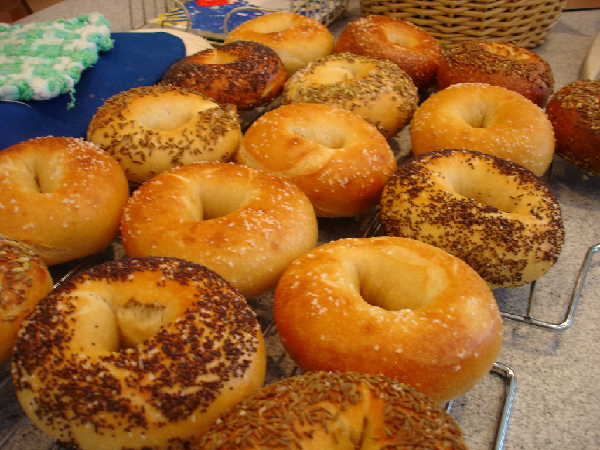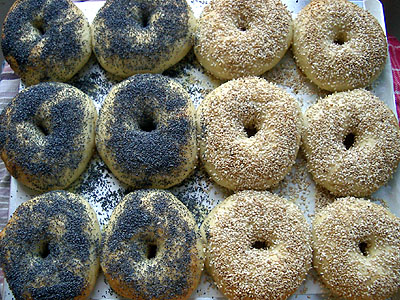
Many thanks to Susanfnp for posting a great sourdough bagel recipe based on Nancy Silverton's bagel recipe. She also provided a number of key tips as I made these. I posted some photos process, as well as a spreadsheet with more details such as bakers percentages and preferment percentages.
Sourdough Bagel Recipe
Ingredients:
- 335 grams (12 oz) 100% hydration white flour starter
- 17 grams (0.6 oz) sugar
- 12 grams (0.4 oz) malt syrup
- 17 grams (0.6 oz) salt
- 2.8 grams (0.1 oz) instant yeast
- 359 grams (12.5 oz) water
- 186 grams (6.5 oz) first clear flour (I used KA First Clear Flour. Substitute a high ash or whole grain flour - maybe rye, whole wheat, Heartland Mills Golden Buffalo, or just use white flour)
- 578 grams (20.5 oz) high gluten flour (I used KA Sir Lancelot High Gluten Flour. Substitute bread flour or other high protein white flour.
Mix Dough - Day Before Baking
I used a mixer. While reading the Nancy Silverton recipe, the idea seems to be to get a very stiff dough. I decided the mixer might save some effort. Nancy Silverton specifies 8 minutes at a medium speed.
Add starter to mixer bowl, then mix water, yeast, sugar, and malt syrup and add to the mixing bowl. Mix ingredients well with a spoon or whisk. Mix flours and salt so they are well integrated, then add them all to the mixing bowl and stir with a spoon or whisk to get most of the flour wet.
Mix at low speed until ingredients form a mass, then mix at medium. Total mix time should be about 8 minutes. The result should be a supple but not at all tacky dough. You should be able to work with this dough easily with dry hands on a dry counter. If it is at all sticky, you probably have too much water in it. The objective is to end up with no flour dust, since you want the bagels to come out smooth and have a sheen. That won't happen if you get flour dust on them.
Remove dough from mixer and knead on the counter a few times to verify the consistency of the dough is correct. It should become a satin, supple, somewhat stiff, not tacky dough that is easy to work with.
Shaping
Divide the dough into about 18 3 ounce pieces. Since the dough is so dry, it may develop a dry skin fairly quickly, so proceed smartly to the shaping stage. Don't dilly dally at this point, as the dough pieces will become too puffy quickly if they are allowed to sit at room temperature for very long. However, the pieces need to rest a short time, maybe 5 to 10 minutes, so that the gluten will be relaxed enough to shape the bagels.
If you have a fine mist spray (I have an atomizer meant for olive oil that I use for water), you can make shaping easier and avoid the dry skin, particularly on the pieces you shape last, by spraying a tiny amount of water on the pieces before you shape them.
To form the bagels, roll out an 8 inch rope shape with your palms. If the dough is too stiff or you make a mistake and want to start over, let that piece rest a few more minutes, and move to the next piece. Take the 8 inch rope and hold it between your palm and your thumb. Wrap the rope around your hand and bring the other end together with the end you are holding between your palm and thumb. You now have a "rope bracelet" wrapped around your hand. Rub the seams together on the counter to seal them, then take off the bracelet, which should look a lot like a bagel, hopefully. Stretch it out so you have a large 2.5 inch hole. It looks big, but it will shrink or even disappear as the dough rises during boiling and baking. The hole needs to be big looking compared to a normal bagel.
Place the bagels on parchment dusted with semolina flour on a sheet. Cover with saran or foil or place the whole sheet in an extra large food storage bag (XL Ziploc is what I'm thinking here). The idea is to lock in moisture to avoid any dry skin forming yet allow room for some slight expansion as they puff up. Place the sheets in the refrigerator to retard overnight.
Boiling
Bring 5 quarts of water and 1 tablespoon of baking soda in a good sized stock pot to a boil. Place a bagel in the pot and make sure it floats to the top. If so, you can do 4-6 bagels at one time. They should only be in the water for about 20 seconds. Push them under periodically with a wooden spoon, so the tops are submerged for a few seconds. In my case, I never managed to get the bagels out before about 30 seconds were up, but they came out fine. If the test bagel won't float, lift it out with a slotted spoon, and gently pat it dry and allow the bagels you have removed from the refrigerator (I did 6 of them at a time) to sit at room temperature for about 20 minutes and try again. In my case, they floated immediately out of the refrigerator, probably because I was a little slow getting the dough formed and shaped the previous night. I took the sheets out one at a time, so I could keep the bagels from getting too warm, since I was only doing 6 at a time.
Dip in Seeds
Make plates of seed beds. I made three seed beds. One was 2 parts caraway seed, 1 part anise seed, and a pinch of salt. Another was 2 parts dill seed, 1 part fennel seed, and a pinch of salt. The last was poppy seed and a pinch of salt. I also made salt bagels, but those were done by just sprinkling a little kosher salt on some of them with my fingers.
Right after the bagels are removed from the boiling water with a slotted spoon, place them on a rack to cool for a few seconds. After they have cooled of slightly and dried enough not to ruin the seed bed with too much wetness, pick one up and place it round side down (the tops down), and gently press them into the seed bed. Pick them up and place them right side up on a sheet lined with parchment paper and dusted lightly with semolina flour or coarse corn meal.
Baking
Preheat the oven to about 400F. No preheat may work, but I'm not sure. It seems easy, from my limited experience, for them to rise too much. The result will be an open bread-like crumb, instead of the very chewy, more dense crumb expected in a bagel. So, I didn't risk a no-preheat strategy in this case.
If you have a stone, you can transfer the parchment paper on a peel to the stone and bake directly on the stone. I baked them for about 20 minutes at 400F. You can also bake them on the sheet.
Cool
Allow the bagels to cool.
Results
The bagels were chewy and delicious. The crumb was more open than I wanted. The reasons for the open crumb were probably two things: 1) I delayed too long in the mixing, shaping, and covering stage the night before. 2) I made a mental error during the mixing and left out about 78 grams of flour from the recipe. The higher hydration contributed to a slightly less dense crumb, I believe. The recipe amounts are adjusted to reflect what I think are the correct amounts for the flour choices above. The important thing is to get a very firm dough and not to let the dough or the bagels rise too much during the various stages leading up to baking.






